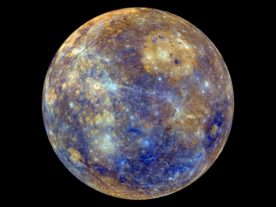
How Will Our Sun Die?
Scientists say our Sun has been shining for about the last 4.6 billion years. They also say the Sun is expected to have enough hydrogen to fuel nuclear fusion in its core to allow it to continue shining as it has for about another 5 billion years. Along with creating solar energy, the Sun’s hydrogen […]

Calculations Show Mercury Has a Thin but Dense Crust
Mercury is the closest planet to the Sun, and very little is really known about this hot rocky orb. So far, only two space probes have ever studied Mercury. NASA’s Mariner 10 flew past the planet three times between 1973 and 1974. The flybys allowed scientists to map about half the planet, discover its thin […]

Life May Exist Among the Clouds of Venus
The search for extraterrestrial life has included examining the possibilities within and outside of the solar system. It has been thought that Mars and a couple of the moons of Saturn and Jupiter may hold the chance of having ET life. It’s also thought by some that a number of Earthlike extrasolar or exoplanets residing […]
Dark Matter Imaged; Shoe-String Theory; Metal in Mars Atmosphere
Dark Matter Filaments of Cosmic Web Imaged Two Canadian researchers say that they have constructed a composite image of dark matter filaments that make up what cosmologists call the cosmic web. Scientists have been finding evidence that our universe may be anything but random and that everything is actually organized and connected to each other […]

Venusian Atmosphere; Space Mice Liver Trouble; Gravitation Wave Light Pulse
New Details of Venusian Atmosphere Revealed The European Space Agency’s Venus Express orbited Earth’s closest planetary neighbor for over eight years until its mission ended in December 2014. In its final months the spacecraft was sent deep into the Venusian atmosphere for a series of low-altitude orbits. Studying data of a previously unexplored piece of […]

Bright Spots on Ceres; Sorry No Alien Structure; New Lie-Detector
Scientists Learn More about Dwarf Planet Ceres Scientists think they may know what’s behind the mysterious bright spots on the Ceres and where the dwarf planet may have originated. Studying data gathered by NASA’S Dawn spacecraft the researchers outlined their findings in a pair of new studies published in the journal Nature. In one study, […]

Science Scanner: Venus Mission Ends, Organic Chemistry on Mars, Hormone Changes in Expectant Dads, New High in CO2 Output
ESA’s Venus Express Mission Ends The European Space Agency (ESA) announced this week that the space probe it sent to orbit Venus back in 2006 has reached the end of its life. Called the Venus Express, the spacecraft ran out of its propellant after executing a number of thruster burns that returned the probe to […]
Rising Levels of Human-Caused Water Vapor in Troposphere will Intensify Climate Change Projections
When it comes to greenhouse gases that contribute most to global warming, most people think of substances such as carbon dioxide, methane or even hydrofluorocarbons. But did you know that, for a while now, scientists have considered the vapor of the most important ingredient in sustaining life on Earth – water – as one of […]
Science Scanner: Leonardo da Vinci Might be Wrong and is Planet Mercury a Hit-and-run Victim?
Scientists Catch Photosynthesis in Action Researchers have snapped the very first images of photosynthesis as it happens. Photosynthesis is the process which plants use to convert light energy into chemical energy, which is then stored as sugar. Using the U.S. Department of Energy’s LCLS x-ray laser, the world’s most powerful, the researchers imaged the part […]
Rare Astronomical Event Occurs Tuesday in US
On Tuesday, June 5, people in most parts of the world have a good chance of witnessing a once-in-a-lifetime astronomical event called the transit of Venus. It’s a planetary alignment which occurs when the planet Venus passes directly between the Earth and sun. For those of us here on Earth, it’ll look like a little […]
